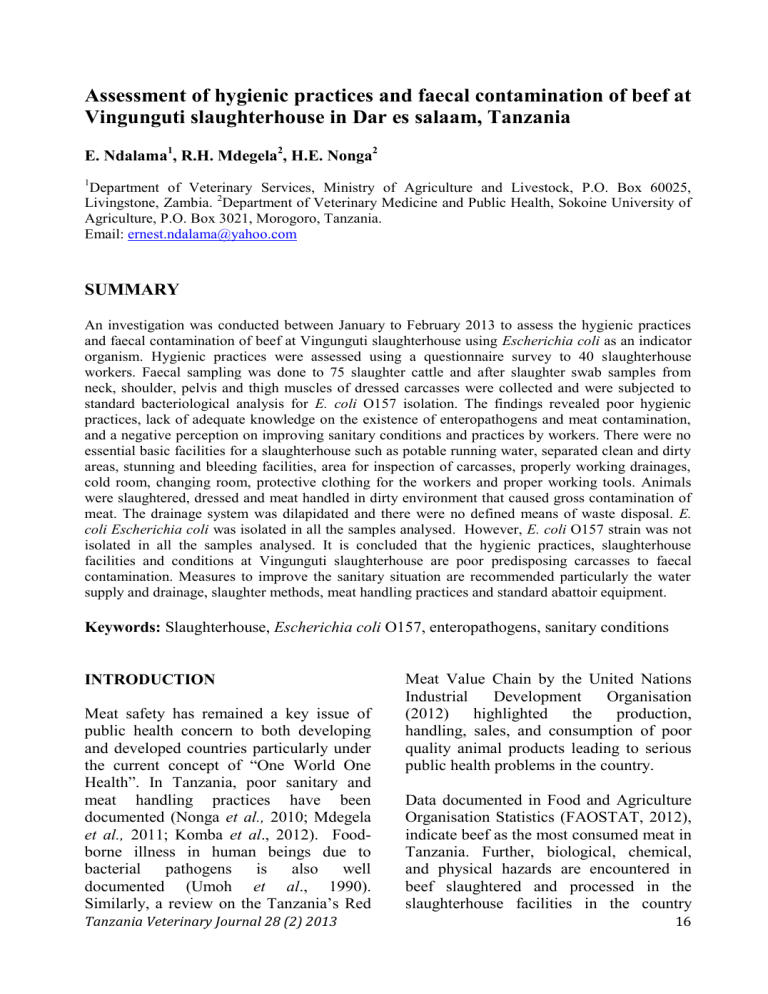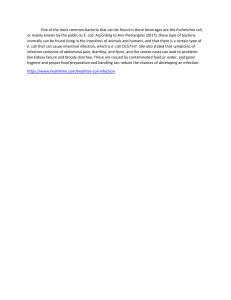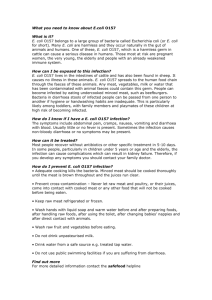
Assessment of hygienic practices and faecal contamination of beef at Vingunguti slaughterhouse in Dar es salaam, Tanzania E. Ndalama1, R.H. Mdegela2, H.E. Nonga2 1 Department of Veterinary Services, Ministry of Agriculture and Livestock, P.O. Box 60025, Livingstone, Zambia. 2Department of Veterinary Medicine and Public Health, Sokoine University of Agriculture, P.O. Box 3021, Morogoro, Tanzania. Email: ernest.ndalama@yahoo.com SUMMARY An investigation was conducted between January to February 2013 to assess the hygienic practices and faecal contamination of beef at Vingunguti slaughterhouse using Escherichia coli as an indicator organism. Hygienic practices were assessed using a questionnaire survey to 40 slaughterhouse workers. Faecal sampling was done to 75 slaughter cattle and after slaughter swab samples from neck, shoulder, pelvis and thigh muscles of dressed carcasses were collected and were subjected to standard bacteriological analysis for E. coli O157 isolation. The findings revealed poor hygienic practices, lack of adequate knowledge on the existence of enteropathogens and meat contamination, and a negative perception on improving sanitary conditions and practices by workers. There were no essential basic facilities for a slaughterhouse such as potable running water, separated clean and dirty areas, stunning and bleeding facilities, area for inspection of carcasses, properly working drainages, cold room, changing room, protective clothing for the workers and proper working tools. Animals were slaughtered, dressed and meat handled in dirty environment that caused gross contamination of meat. The drainage system was dilapidated and there were no defined means of waste disposal. E. coli Escherichia coli was isolated in all the samples analysed. However, E. coli O157 strain was not isolated in all the samples analysed. It is concluded that the hygienic practices, slaughterhouse facilities and conditions at Vingunguti slaughterhouse are poor predisposing carcasses to faecal contamination. Measures to improve the sanitary situation are recommended particularly the water supply and drainage, slaughter methods, meat handling practices and standard abattoir equipment. Keywords: Slaughterhouse, Escherichia coli O157, enteropathogens, sanitary conditions INTRODUCTION Meat safety has remained a key issue of public health concern to both developing and developed countries particularly under the current concept of “One World One Health”. In Tanzania, poor sanitary and meat handling practices have been documented (Nonga et al., 2010; Mdegela et al., 2011; Komba et al., 2012). Foodborne illness in human beings due to bacterial pathogens is also well documented (Umoh et al., 1990). Similarly, a review on the Tanzania’s Red Tanzania Veterinary Journal 28 (2) 2013 Meat Value Chain by the United Nations Industrial Development Organisation (2012) highlighted the production, handling, sales, and consumption of poor quality animal products leading to serious public health problems in the country. Data documented in Food and Agriculture Organisation Statistics (FAOSTAT, 2012), indicate beef as the most consumed meat in Tanzania. Further, biological, chemical, and physical hazards are encountered in beef slaughtered and processed in the slaughterhouse facilities in the country 16 E. Ndalama et al. (UNIDO, 2012). The biological hazards are mainly bacterial pathogens such as E. coli O157:H7, Salmonella, Campylobacter and Listeria species (Declan et al., 2004). Escherichia coli is used as an indicator of possible post-processing contamination, and its presence indicates faecal contamination (Hilal et al., 2003). The production process for raw meat can be assessed with respect to microbiological safety by estimation of the growth of E. coli (Greer et al., 1994). In beef carcass, E. coli associated with cattle can increase or decrease during slaughter depending on factors such as the levels of contamination of live cattle, efficiency of evisceration and hygienic practice in the slaughterhouse (Rigobelo et al., 2006). Slaughterhouses are also required to test carcasses for generic E. coli as an indicator of the adequacy of the plant's ability to control faecal contamination. Escherichia coli O157 is a non-sorbitol fermenting, Gram negative rod shaped organism, ranging from 0.7 to 1.5 x 2 to 5 μm in size, oxidase negative, catalase positive and indole positive. These characteristics are used for biochemical confirmation of E. coli O157. Some farm animals, mainly cattle, have subclinical infections with E. coli O157 and hence do not show signs of the illness (Hendriksen, 2003). Such animals are regarded as carriers with potential to shed pathogens in the environment and also to contaminate meat during the slaughter process. Availability of modern slaughter facilities to meet the demand and desirable quality of meat in Dar es Salaam is limited. Vingunguti slaughterhouse is the main public slaughter facility available in the city and is owned by Ilala Municipal Council. Poor sanitary and meat handling practices have been observed in studies conducted at Morogoro Municipal abattoir (Nonga et al., 2010; Komba et al., 2012). The Tropical Veterinarian Further, the Food and Agriculture Organisation (FAO, 2005) data on the nutrition country profile also indicate that the underlying cause of major health problems in Tanzania is poor sanitation and care practices. Most of the meat supplied in Dare es Salaam is slaughtered at Vingunguti slaughterhouse where about 800 animals including cattle, sheep and goats are slaughtered per day, according to a report by Ministry of Livestock and Fisheries Development (MLFD, 2011). With an average slaughter of 280 cattle per day, this facility is the main source of meat for the increasingly growing population in the city. The poor hygienic condition at the slaughterhouse has, of recent, raised concerns by various stakeholders (Edwin, 2010; Mironda, 2011). Nonetheless, no research had been undertaken to determine the quality of the meat carcasses from the facility. The current study was undertaken to assess the level of hygienic practices, status of the slaughter facilities and faecal contamination of beef using E. coli as an indicator organism. Prevalence of enterohaemorrhagic E. coli O157 in beef carcasses was also determined. MATERIALS AND METHODS Study design and area This cross-sectional study was carried out at Vingunguti slaughterhouse which is within Ilala Municipality, in Dar es Salaam Region, Tanzania. Ilala is a central business area with a human population of about one million. Other districts within Dar es Salaam region which use the same facility are Temeke and Kinondoni. Ilala Municipality has one secondary livestock market at Pugu area which deals with buying and selling of live cattle, sheep and goats from all over the country. Ukonga slaughter slabs owned by private individuals is another slaughter facility available in the district. Most of the 17 Hygienic practices and faecal contamination of beef at Vingunguti slaughterhouse residents buy meat from small butcheries and meat shops scattered all over the city. Only few natives and majority of foreigners buy meat from modern supermarkets that sell high quality meat cuts and processed meat products. Vingunguti slaughterhouse was selected because it is the major slaughter facility in Dare es Salaam. Laboratory work was conducted at Sokoine University of Agriculture (SUA), Morogoro. Data and sample collection Data were collected from 40 respondents working in the slaughterhouse using a pretested questionnaire. It aimed at collecting information regarding the knowledge, perception and practices on abattoir hygiene and sanitary practices. A checklist of standard abattoir hygiene and sanitary facilities and practices, adopted from the standard design for small-scale modular slaughterhouse (FAO, 1998) and meat inspectors manual and abattoir hygiene (National Department of Agriculture, 2007), was used to check for compliance to hygienic standards of the slaughterhouse. A total of 75 animals were sampled within the two weeks of the study. From the 75 animals, 300 carcass swabs and 75 faecal samples were collected. The sample size was determined using Epi info7 programme (Center for Disease Control and Prevention (CDC, 2012) for sample size determination for unknown population, at 5% expected frequency, 5% confidence limit and with 95% confidence level. Five samples for bacterial isolation were collected from each animal during the slaughter process. Approximately 10 g of a faecal sample was collected directly from the rectum with gloved hand, put into sterile universal bottle and stored in a cool box until analysis. Soon after the slaughter process was completed, four swabs were Tanzania Veterinary Journal 28 (2) 2013 collected from each dressed carcass. One swab was collected per each sampling area of the carcass namely the neck, pelvis, shoulder and thigh. An area measuring 100-cm2 on carcass surface was swabbed using sterile cotton swabs. Thereafter, each swab was suspended in sterile universal bottle containing 10 ml buffered peptone water (BPW) (peptone 1.00 g/L, sodium chloride 4.30 g/L, disodium hydrogen phosphate 7.23 g/L, potassium dihydrogen phosphate 3.56 g/L; pH 7.0) stored in a cool box packed with ice cubes and transported to the laboratory at SUA, for analysis. The samples were processed using the standard bacteriological procedures described by Invitrogen Dynal AS, Oslo, Norway (2007). Isolation and identification of E. coli and E. coli O157 From the 10 g faecal sample, a 10% suspension in physiological saline was prepared and 1 ml transferred into 10 ml BPW enrichment broth. Both 10 ml faecal and suspension of the swabbed sample were incubated for 6-18 hours at 37oC. Immuno-magnetic separation (IMS) was later performed using the DynabeadsR on all the samples together with a positive control, according to the protocol prescribed by Invitrogen Dynal AS (Oslo, Norway), the manufacturers of the DynabeadsR. After IMS, the suspended beads were inoculated by spreading on Violet Red Bile Agar (VRBA, Oxoid, Basingstoke, England) for isolation and identification of the E. coli. All the uniform, round, pinkish colony isolates seen after incubation at 44°C for 24 hours from swabs and faecal samples on VRBA tentatively regarded as E. coli were further characterized biochemically based on methods described by McFaddin (1977), Barrow and Feltham (1993) and Bopp et al. (1999). Isolates identified biochemically as E. coli were further screened on Cefixime 18 E. Ndalama et al. Tellurite Sorbitol MacConkey (CT-SMAC) (Oxoid, Basingstoke, UK) by incubation for 24 hours at 37°C. Colonies that appeared colourless (non-sorbitol fermenters) on CT-SMAC were presumptively identified as E. coli O157 and subjected to further screening using oxidase test by picking a pure colony from the CT-SMAC plate with a sterile loop and striking it onto the oxidase strip (Oxoid, Basingstoke, UK). A blue colour change observed on the strip within 3-5 seconds signified a positive result while a lack of colour change represents a negative result. Oxidase test is characteristically negative for E. coli. Data Analysis The Statistical Package for Social Scientists (SPSS) was used to analyse questionnaire data using descriptive statistics frequencies while Epi Info Version 7 was used for statistical analysis of the laboratory-based data. RESULTS Questionnaire data All the 40 workers interviewed in the slaughterhouse, were males of whom 65% had primary school education, 22.5% secondary school education and 12.5% post-secondary education (Figure 1). Figure 1. Level of education of the workers at Vingunguti slaughterhouse (n= 40) Of the total respondents, 57.5% had worked at Vingunguti slaughter facility for more than 10 years and 62.5% were aware of the existence of enteropathogens. Furthermore, 77.5% indicated the need for knowledge on enteropathogens while 85% needed the knowledge on sources and side The Tropical Veterinarian effects of meat contamination. Regarding the pathogenic contaminants of meat, 70% of respondents were aware of the pathogenic contaminants of meat while 85% needed the knowledge. Regarding knowledge on contamination, 57.5% agreed to the statement that ‘meat is never 19 Hygienic practices and faecal contamination of beef at Vingunguti slaughterhouse contaminated by faeces during the slaughter processes’. The majority (70%) of the workers agreed that ‘only meat which appears visually dirty is contaminated’. A further 60% agreed that ‘washing with clean water removes any contamination from the meat’ while 45% respondents agreed that ‘meat from animals slaughtered on the floor does not become contaminated.’ About perception of enteropathogens and meat contamination, 97.5% agreed that ‘enteropathogens are very harmful to humans’ while 70% agreed that ‘efforts to prevent enteropathogens in the slaughterhouse would be destined to fail.’ About two thirds (67.5%) agreed that ‘enteropathogens are rare pathogens in meat’ while 60% stated that ‘once in the slaughterhouse, it is not possible to control enteropathogens,’ 42.5% were of the view that ‘getting infected with enteropathogens is very difficult’. Similarly, on perception of beef contamination with enteropathogens, even though 95% of the respondents thought that ‘beef contamination with enteropathogens is very dangerous,’ 52.5% also agreed that ‘beef contamination with enteropathogens during slaughter is very difficult.’ Only 7.6% disagreed with the statement that ‘any meat could get enteropathogens and faecal contamination during slaughter’ and was outweighed by the 62.5% who agreed that ‘no one can get enteropathogens from contaminated meat.’ Over half of the respondents (57.5%) stated that ‘once in the slaughterhouse, it is not possible to control meat contamination,’ while an equal percentage (57.5%) supported the statement that ‘efforts to prevent meat contamination in the abattoir would be destined to fail.’ Further analysis of the responses from the workers regarding hygienic practices at the slaughterhouse is shown in Table 1. Table 1. Responses of workers at Vingunguti slaughterhouse regarding hygienic practices in the slaughterhouse (N=40) Agree Hygiene practice (%) Hygiene procedures are followed in the slaughterhouse 87.5 Workers are provided with protective clothing 75.0 Workers report injuries and infectious diseases 75.0 Workers wash hands with soap and running water immediately when they become soiled 75.0 Workers wash hands with soap and running water immediately after having using a toilet 95.0 Workers wash hands with soap and running water when entering the working area 87.5 Workers received some training in hygiene procedures before 80.0 Physical checks on hygienic practices and status of available slaughter facilities Through physical check and comparing with a checklist of standards for abattoir sanitary facilities and hygiene practices, it Tanzania Veterinary Journal 28 (2) 2013 was established that most of the sanitary facilities such as piped running water, recommended equipment, toilets and change rooms, accessibility to sterilizers, hand washers, properly working drainage system, demarcation between the ‘clean’ and ‘dirty’ areas of slaughter operations 20 E. Ndalama et al. and the protective clothing for the personnel were lacking in the slaughterhouse. All the slaughter operations; slaughtering, bleeding, evisceration and portioning were done manually on the dirty floor using dirty knives and axes by dirty personnel with inadequate lighting in the slaughter shed. The casual workers employed by the traders to work in the slaughter facility to slaughter animals were untrained and careless. The majority of them were present in all stages of the processing activities from slaughtering to carcass dressing, evisceration and portioning with no separation between the dirty and clean procedures. Carcasses were not washed mainly due to lack of water; no cold room storage facility was available hence the meat was distributed to the market outlets immediately after the slaughter process. The slaughter hall was dirty with the dilapidated drainage system used for washing offals and intestines with inadequate waste disposal facilities. All slaughter operations were done in one place with no running water for washing hands, tools, and the carcasses. No proper hand tools were available, and there was no control of people working in the slaughter hall. Moreover, there was no regulation of their attire, meat inspection was not thoroughly conducted, and the place was overcrowded. There was cross flow of the waste and cross-contamination of the carcasses posing a serious threat to public health through meat contamination. The condemnation pit was full of decomposing condemned organs with heavily covered with thousands of flies and the abattoir was not fenced. Laboratory results on E. coli and E. coli O157 The immuno-magnetic separation and the plating of samples on VRBA showed that the uniform, round, pinkish colony isolates The Tropical Veterinarian which were morphologically and biochemically identified as E. coli were isolated from all the 375 samples. Screening the isolates on the selective agar plates of CT-SMAC with the view of isolating the characteristic sorbitol negative E. coli O157, resulted into 61.6% pure pink lactose positive colonies, 32.3% mixed colonies of pink lactose positive with colourless lactose negative, and 2.4% pure colourless lactose negative colonies. The harvested colonies on CT-SMAC did not show the slight transparent, almost colourless to weak pale brown, with a typical diameter of about 1 mm which are the characteristic features of E. coli O157. The biochemical oxidase test, which is characteristically negative for E. coli was done on 130 lactose positive samples with pure pink as well as mixed colonies and resulted into 127 (97.7%) oxidase positive results. The remaining three of the 130 samples (2.3%) which produced the oxidase negative result, could not yield the characteristic transparent, colourless to weak pale brownish appearance of sorbitol negative colonies when sub cultured on CT-SMAC. Thus only other E. coli strains were isolated from all the 375 samples and no strains of E. coli O157 were isolated. DISCUSSION This study was conducted to assess the hygienic practices and faecal contamination of beef at Vingunguti slaughterhouse using Escherichia coli as an indicator organism. The findings show that there were poor hygienic practices and that 100% faecal contamination of beef carcasses slaughtered at Vingunguti slaughterhouse. There were no strains of E. coli O157 isolated from the analysed samples. The study findings are comparable to those by Arenas et al. (2004) in Venezuela, Bello et al. (2011) in Nigeria and (Nonga et al., 2010; Mdegela et al., 2011; Komba et al., 2012) in 21 Hygienic practices and faecal contamination of beef at Vingunguti slaughterhouse Morogora, Tanzania. Carcasses are exposed to bacteria of faecal origin during the slaughtering and subsequent processes. The surfaces, intestines of the animal, equipment, air and the water used in washing carcasses if contaminated (Bello et al., 2011) and hands of the workers, all serve as routes of contamination. Proper sanitation, on the other hand, reduces the amount of bacteria in all work areas and on the equipment, and therefore, has a direct effect on the quality of meat supplied to the consumers. With some level of literacy, most of the workers in the Vingunguti slaughterhouse, demonstrated that they were aware of the existence of enteropathogens but needed more indepth knowledge on both enteropathogens and meat contamination. Even though majority of the respondents correctly stated that ‘in the slaughter facility meat contamination with enteric pathogens can be controlled,’ most of them further demonstrated that their perception of the measures to control beef contamination with enteropathogens was negative. The poor slaughtering techniques observed involving the slaughtering of animals without stunning, poor bleeding out, damaging intestines when eviscerating, use of untrained and careless casual workers employed by traders using the facility, lack of enough working spaces and cramped working conditions as well as hasty slaughtering procedures with soiled hands and equipment not regularly washed, are practices which possibly contributed to the observed high faecal contamination. The lack of running water further made it difficult to maintain the required standard of hygiene. The need for quality potable water to be used as a universal cleaning medium in slaughterhouse sanitation has been demonstrated in other studies by Bello et al. (2011) and Arenas et al. (2004) in which increase in bacterial counts were Tanzania Veterinary Journal 28 (2) 2013 observed on beef carcasses after washing them contaminated water. In the present survey, findings of the questionnaire data showed that good hygiene was practised by majority of the workers. However, this was contradicted by the findings on the actual hygienic practices captured by the checklist supported by personal observations during data collection which revealed poor hygienic practices and lack of essential basic facilities. The learning point here is that some hygienic requirements may appear so basic and seem obvious but affect the personal hygiene of workers as well as health aspects relating to all staff working in the slaughterhouse. The daily provision of clean, appropriate protective clothing and the necessary infrastructure in respect of toilet facilities, the provision of water, soap, toilet paper, and hand wash basins are basic standard hygiene requirements which lacked at the slaughterhouse and yet people still believed that good hygiene was practised. It is therefore extremely important that the management and workers of any slaughter facility are fully informed of their duties with respect to hygiene in order to reduce the extent of meat contamination. Although no strains of E. coli O157 were isolated from both faecal samples and carcass swabs in this investigation, observed results appear to be comparable to those reported in earlier studies by Arenas et al. (2004) from an abattoir in Venezuela where strains of E. coli O157 were not detected and a lower prevalence (26.7%) of E. coli was recorded than was recorded in the current study (100%). Variations in prevalence of E. coli may be accounted for by differences in the slaughter environments and conditions, slaughter methods used, and the personnel involved in the slaughter process. Similarly, studies by Bello et al. (2011) 22 E. Ndalama et al. revealed a slightly higher prevalence (2.8%) of E. coli O157 strains from swabs of beef carcasses from three abattoirs in Nigeria. The reported slaughter conditions of cattle in their study such as absence or dilapidated and non-functional status of facilities in abattoirs, lack of standard order of process operations such as stunning, line dressing or chilling and animals being cast, slaughtered and processed on the floor of the slaughter hall, were similar to the slaughter conditions in the present study. Other studies by (Nonga et al., 2010; Mdegela et al., 2010; Komba et al., 2012) conducted in slaughter facilities in Morogoro Municipality, Tanzania, have documented similar findings of poor hygienic practices and slaughter conditions in slaughter facilities and have recorded high prevalence of other enteric pathogens such as Campylobacter (66.7%). The high contamination with enterobacteria in these studies can be attributed mainly to the lack of standard operating procedures and poor hygienic practices in most slaughter facilities. While the inability to isolate E. coli O157 in this study and other earlier studies implies that there was no E. coli O157 in the animals and environment. However, E. coli O157 isolation presents challenges in that it occurs in very low numbers in the faeces of infected cattle and may be out competed by other resident background micro flora (Hendriksen, 2003). The volume of the faeces investigated may also determine the sensitivity of detection; the larger the volume the higher the sensitivity. Volumes commonly applied range from a swab of less than 1 g to 25 g (Hendriksen, 2003). In this study, 10 g were used as prescribed in the protocol from Invitrogen Dynal AS (Oslo, Norway) to prepare a 10% solution with the enrichment broth of BPW. This quantity was large enough as compared to other quantities below 10 g which are commonly advised. Even if the sensitivity is increased by concentration of cells from The Tropical Veterinarian enrichment culture by IMS, the DynabeadsR, however, might record a false negative between 2-10% depending on the inoculum level and background flora (Hendriksen, 2003). The false negative result is significantly increased in the same sample, without IMS and is often more than 25%. Some sorbitol positive E. coli O157 may also fail to be detected on CTSMAC plates (Hendriksen, 2003). In conclusion, the current study assessed the hygienic characteristics of the beef slaughtering process and revealed that the hygienic conditions of the beef carcasses slaughtered in Vingunguti slaughterhouse is poor. The microbial contamination indicated by E. coli on the beef carcasses clearly suggested that the slaughterhouse may be a potential risk and contributor to the many health problems associated with poor sanitation and care practices as documented by FAO (2005) on the nutrition country profile for Tanzania. Although the risk of exposure to E. coli O157 is low, the population being exposed to the risks of consuming meat contaminated by other enteric pathogens is likely to be high. More work, including surveillance activities at the Vingunguti slaughterhouse, needs to be undertaken to check for other enteric pathogens. Necessary measures also need to be put in place to address the current pathetic situation including the requirement for application of Sanitation Standard Operating Procedures (SSOP). The “clean” and “dirty” areas in the slaughter facility need to be separated by distance, physical barriers, time, or even the roles performed by different workers. Basic standards on slaughterhouse practices need to be set and adhered to by all persons entering the slaughterhouse facilities. All personnel must not only be trained in hygiene procedures and personal hygiene matters, but also receive training on good practices, cleaning and sanitation procedures, 23 Hygienic practices and faecal contamination of beef at Vingunguti slaughterhouse personal safety and their specific roles in sanitary programmes. A well-designed and constructed abattoir which would systematically process the slaughter animals owing to the large demand of beef in Dar es Salaam city may be a matter for urgent consideration. ACKNOWLEDGEMENTS The authors wish to acknowledge the cooperation received from Makalinge, J. and Makingi, G. for their technical support; Mr. Juma, officer in-charge at Vingunguti slaughterhouse is thanked for facilitating the sampling work. The work was a result of the SADC TADS Project support to the 2012 MPVM cohort. REFERENCES Arenas ML, Huerta-Leidenz N, Ortiz Y, ValeraMatos M, Smith CG. Microbiological contamination on beef carcasses in a small abattoir in Venezuela. Departmental Research Reports Colorado State University, 2004. [http://ansci.colostate.edu/content/view/51]. Barrow GI, Feltham RKA. Cowan and Steel's Manual for identification of medical Bacteria, third ed. Cambridge University Press, London, pp. 128–147, 1993. Bello M, Lawan MK, Kwaga JKP, Raji MA. Assessment of carcass contamination with E. coli O157 before and after washing with water at abattoirs in Nigeria. Int J Food Microbiol 150: 184–186, 2011. Bopp CA, Brenner FW, Wells JG, Strockbine NA. Escherichia, Shigella, and Salmonella, In: Murray PR, Baron EJ, Pfaller MA, Tenover FC, Yolken RH (Eds.), Manual of Clinical microbiology, seventh ed. ASM press, Washington, D.C, pp. 459–471, 1999. Declan JB, Alice MD, James JS. Beef HACCP: intervention and non-intervention system. Int J Food Microbiol 66: 119–129, 2004. Edwin A. Dar es Salaam abattoir for massive renovation. Daily News, issue of 5th December 2010. FAO. Tanzania Nutrition Profile – Nutrition and Consumer Protection Division, FAO, Rome. Tanzania Veterinary Journal 28 (2) 2013 [ftp://ftp.fao.org/ag/agn/nutrition/ncp/tza.pdf] , 2005. FAO. Standard design for small-scale modular slaughterhouses, [http://www.fao.org], 1998. FAOSTAT. CountrySTAT United Republic of Tanzania, Food and Agriculture Organisation, Rome. [www.agriculture.go.tz], 2012. Greer GG, Gill CO, Dilts BD. Evaluation of the bacteriological consequences of the temperature regimes experienced by fresh chilled meat during retail display. Food Res Int 27: 371–377, 1994. Hendriksen RS. Isolation and identification of enterohaemorrhagic Escherichia coli O157. Laboratory protocols level 4 training courses, 2003. Hilal B, Ibrahim C, Firkret K, Randy W, Kadir H. Relationship among faecal coliform and Escherichia coli in various foods. European Food Technol 26, 331–334, 2003. Invitrogen Dynal AS. Protocols for sample preparation, performing immunomagnetic separation and detection and confirmation of E. coli O157. Oslo, Norway, 2007. Komba EVG, Komba EV, Mkupasi EM, Mbyuzi AO, Mshamu S, Luwumba D, Busagwe Z. and Mzula A. Sanitary practices and occurrence of zoonotic conditions in cattle at slaughter in Morogoro Municipality, Tanzania: Implications for public health. Tanz J Health Res 14: 2, 2012. McFaddin JF. Biochemical Tests for Identification of Medical Bacteria, first ed. The William and Wilkins Company, Baltimore, pp. 392– 452, 1977. Mdegela RH, Laurence K, Jacob P, Nonga HE. Occurrence of thermophilic Campylobacter in pigs slaughtered at Morogoro slaughter slabs, Tanzania. Trop Anim Health Prod 43: 83-87, 2011. Mirondo R. Abattoir Hygiene Disappoints Govt. The Citizen Newspaper, issue of 4th January 2011. Ministry of Livestock and Fisheries Development (MLFD). Budget Speech 2010/1, Dodoma, Tanzania, [http://www.mifugo. go.tz], 2011. National Department of Agriculture, Republic of South Africa. Meat inspectors’ manual and abattoir hygiene, 2007. Nonga HE, Sells P and Karimuribo ED. Occurrence of thermophilic Campylobacter in cattle slaughtered at Morogoro Municipal abattoir, Tanzania. Trop Anim Health Prod 42(1): 73-8, 2010. 24 E. Ndalama et al. Rigobelo EC, Stella AE, Avila FA, Macedo C, Marin JM. Characterization of Escherichia coli isolated from carcasses of beef cattle during their processing at an abattoir in Brazil. Int J Food Microbiol 110: 194–198, 2006. Umoh VJ, Adesiyun AA, Gomwalk NE. The occurence of Staphylococcus aureus in fermented milk products (fura and manshanu) The Tropical Veterinarian in Nigeria. Int J Food Microbiol 10: 343– 347, 1990. United Nations Industrial Development Organisation. Tanzania’s Red Meat Value Chain: A diagnostic. Africa Agribusiness and Agroindustry Development Initiative (3ADI) Reports, Vienna, Austria, 2012. 25




